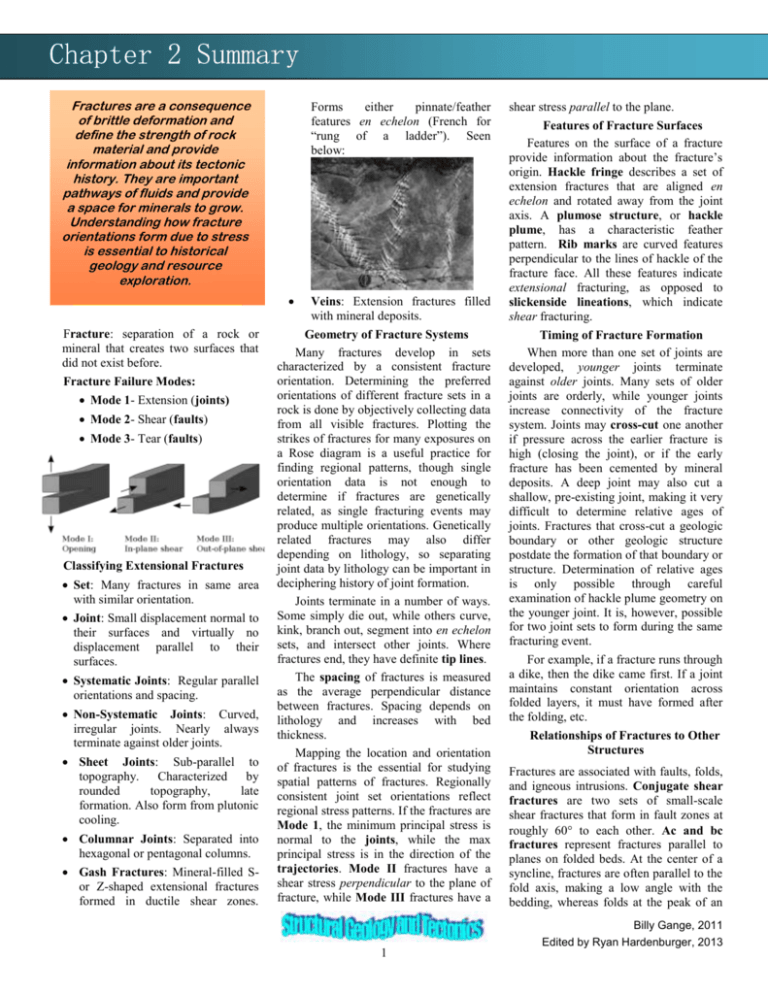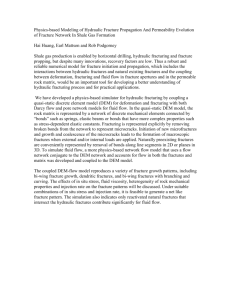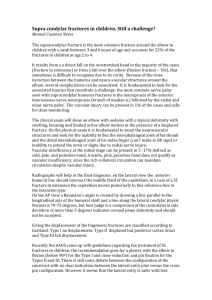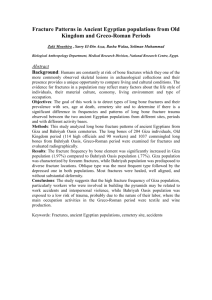Fractures and Joints
advertisement

Fractures are a consequence of brittle deformation and define the strength of rock material and provide information about its tectonic history. They are important pathways of fluids and provide a space for minerals to grow. Understanding how fracture orientations form due to stress is essential to historical geology and resource exploration. Forms either pinnate/feather features en echelon (French for “rung of a ladder”). Seen below: Fracture: separation of a rock or mineral that creates two surfaces that did not exist before. Fracture Failure Modes: Mode 1- Extension (joints) Mode 2- Shear (faults) Mode 3- Tear (faults) Classifying Extensional Fractures Set: Many fractures in same area with similar orientation. Joint: Small displacement normal to their surfaces and virtually no displacement parallel to their surfaces. Systematic Joints: Regular parallel orientations and spacing. Non-Systematic Joints: Curved, irregular joints. Nearly always terminate against older joints. Sheet Joints: Sub-parallel to topography. Characterized by rounded topography, late formation. Also form from plutonic cooling. Columnar Joints: Separated into hexagonal or pentagonal columns. Gash Fractures: Mineral-filled Sor Z-shaped extensional fractures formed in ductile shear zones. Veins: Extension fractures filled with mineral deposits. Geometry of Fracture Systems Many fractures develop in sets characterized by a consistent fracture orientation. Determining the preferred orientations of different fracture sets in a rock is done by objectively collecting data from all visible fractures. Plotting the strikes of fractures for many exposures on a Rose diagram is a useful practice for finding regional patterns, though single orientation data is not enough to determine if fractures are genetically related, as single fracturing events may produce multiple orientations. Genetically related fractures may also differ depending on lithology, so separating joint data by lithology can be important in deciphering history of joint formation. Joints terminate in a number of ways. Some simply die out, while others curve, kink, branch out, segment into en echelon sets, and intersect other joints. Where fractures end, they have definite tip lines. The spacing of fractures is measured as the average perpendicular distance between fractures. Spacing depends on lithology and increases with bed thickness. Mapping the location and orientation of fractures is the essential for studying spatial patterns of fractures. Regionally consistent joint set orientations reflect regional stress patterns. If the fractures are Mode 1, the minimum principal stress is normal to the joints, while the max principal stress is in the direction of the trajectories. Mode II fractures have a shear stress perpendicular to the plane of fracture, while Mode III fractures have a 1 shear stress parallel to the plane. Features of Fracture Surfaces Features on the surface of a fracture provide information about the fracture’s origin. Hackle fringe describes a set of extension fractures that are aligned en echelon and rotated away from the joint axis. A plumose structure, or hackle plume, has a characteristic feather pattern. Rib marks are curved features perpendicular to the lines of hackle of the fracture face. All these features indicate extensional fracturing, as opposed to slickenside lineations, which indicate shear fracturing. Timing of Fracture Formation When more than one set of joints are developed, younger joints terminate against older joints. Many sets of older joints are orderly, while younger joints increase connectivity of the fracture system. Joints may cross-cut one another if pressure across the earlier fracture is high (closing the joint), or if the early fracture has been cemented by mineral deposits. A deep joint may also cut a shallow, pre-existing joint, making it very difficult to determine relative ages of joints. Fractures that cross-cut a geologic boundary or other geologic structure postdate the formation of that boundary or structure. Determination of relative ages is only possible through careful examination of hackle plume geometry on the younger joint. It is, however, possible for two joint sets to form during the same fracturing event. For example, if a fracture runs through a dike, then the dike came first. If a joint maintains constant orientation across folded layers, it must have formed after the folding, etc. Relationships of Fractures to Other Structures Fractures are associated with faults, folds, and igneous intrusions. Conjugate shear fractures are two sets of small-scale shear fractures that form in fault zones at roughly 60 to each other. Ac and bc fractures represent fractures parallel to planes on folded beds. At the center of a syncline, fractures are often parallel to the fold axis, making a low angle with the bedding, whereas folds at the peak of an Billy Gange, 2011 Edited by Ryan Hardenburger, 2013 anticline make a high angle with the bedding. Columnar, sheet, foliation and lineations are all associated with igneous intrusions. References & Resources Robert J. Twiss, Eldridge M. Moores, Structural Geology 2nd edition, (W. H. Freeman), p. 37-59, 2006 http://en.wikipedia.org/wiki/Fracture http://eps.berkeley.edu/~burgmann/EPS11 6/reading/Lecture_2.pdf Billy Gange, 2011 Edited by Ryan Hardenburger, 2013 2








